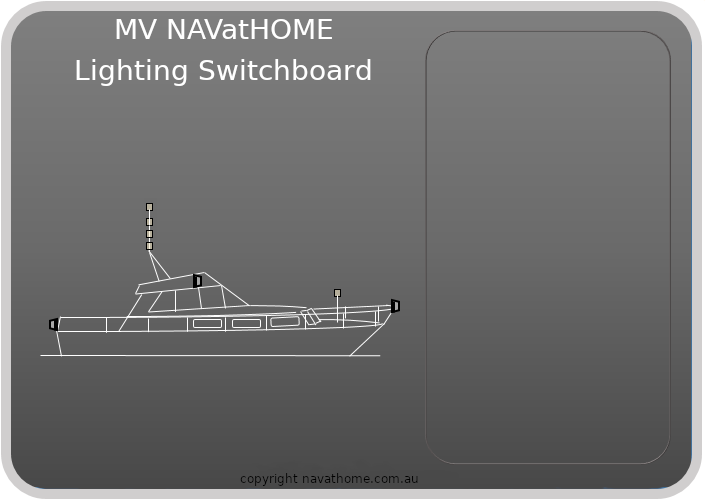Using the switchboard below, and the vessel graphic, you can see the different light configurations available.
Options presented include aspect lights, and type lights.
Aspect lights can be side or stern lights, bicolour and stern lights.
Try the buttons to see which configurations are legal. Definitions and information on the light configuration will be shown under the switchboard.
The screen is too small to interact with the controls, please rotate to landscape to interact with the light controls.



 Deck
Deck Anchor
Anchor Bicolour
Bicolour Mast Steaming Light
Mast Steaming Light FWD Masthead Light
FWD Masthead Light Side Nav Lights
Side Nav Lights NUC
NUC Stern
Stern Searchlight
Searchlight RIAM
RIAM
Deck Light: A working light to facilitate deck work. It can be used at anytime as long as it can not be confused with any over vessel light. It should be used sparingly as it will ruin nightvision.
Anchor Light: A single all round white light. It can also depict a small oar powered vessel, or a vessel that is less than 7 metres in length and is not capable of exceeding 7 knots.
Bi-Colour: For a motor vessel that is less than 12m in length, the side navigation lights can be incorporated into a combined bicolour lantern located at the bow. These lights span an arc of 112.5 degrees either side of the bow. Vessels over 12m in length must use separate side aspect navigation lights.
Masthead Steaming Light: The masthead steaming light indicate that the vessel is under power. It is a single white light, over an arc of 225 degrees, centred pointing towards the vessels bow. It cannot be used on its own, but must be shown with aspect lights. All motor vessels less than 50m in length are required to show at least one steaming light when making way. For vessels less than 12m in length, the steaming light can be incorporated with the stern light as a single all round white light.
Forward Masthead Steaming Light: The forward masthead light, mounted at a height lower than the main masthead light is a secondary light used to show a motor vessel is making way. It should never be used by itself but always in conjunction with aspect lights and the masthead steaming light. Vessels less than 50m in length are not obliged to show a forward light, but may choose to do so.
Side Navigation Lights: Side aspect navigation lights (green on starboard side, red on port side), demonstrate the vessel aspect. These lights span an arc of 112.5 degrees either side of the bow.
Not Under Command: A vessel not under command is any vessel where the helm does not have positive control and therefore cannot take action to avoid a collision. It is depicted using two red lights in a vertical configuration. Power failure, loss of steering, and engine failure are all cases that could be considered to be Not Under Command.
Stern Light: The stern aspect navigation light is a white light that spans an arc of 135 degrees, however on vessels less than 12m in length, the stern light can be integrated with the masthead steaming light as a single all round white light.
Search Light: Searchlights are commonly found on motor cruisers to aid when searching for items lost overboard, finding moorings, or assisting with berthing. They are not vessel headlights and so they should never be used when there is a chance for confusion as another vessel type, and inappropriate use can ruin nighvision and make things more dangerous especially in rain or fog.
Restricted In Ability to Manoeuvre: A light configuration of red, over white, over red, in a vertical configuration is used to demonstrate that a vessel is either restricted in ability to manoeuvre, or if the vessel is also showing an anchor light, it may be involved in diving operations.
